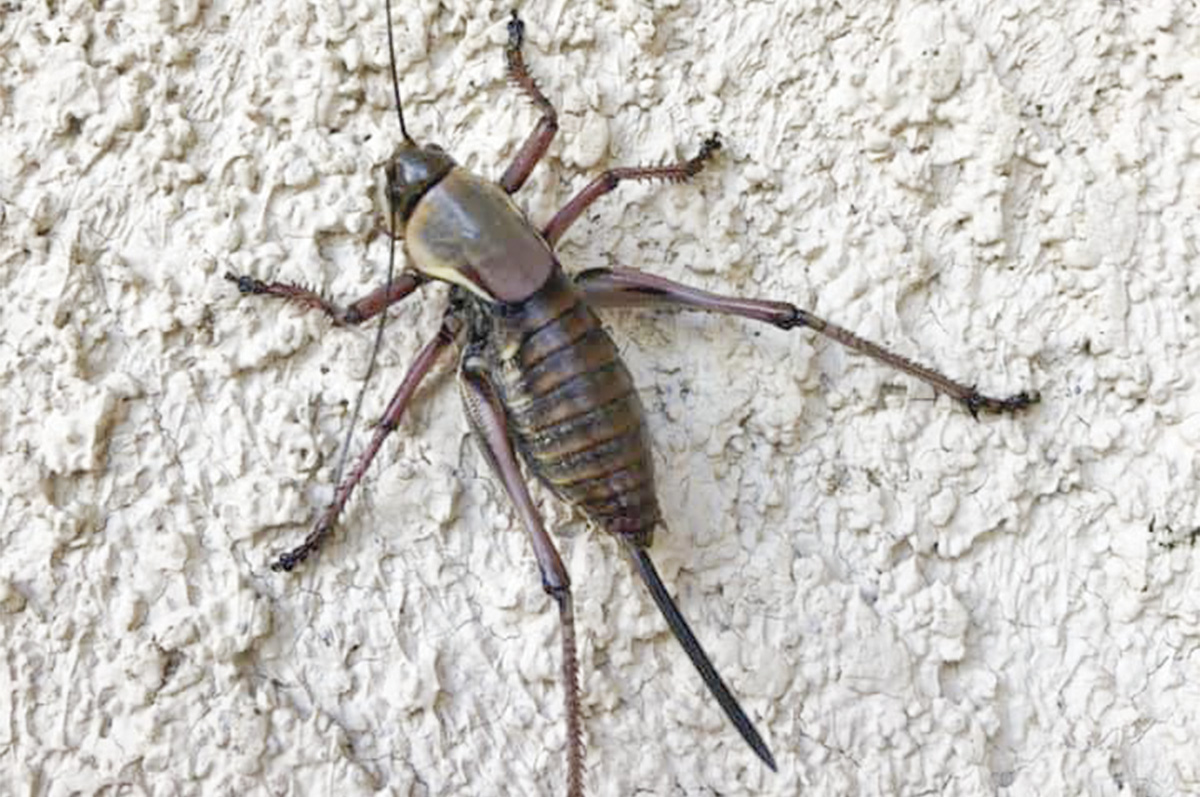While the eastern U.S. gets bombarded with large broods of cicadas this year, here in the West we face an ongoing threat that’s more than just noise – relentless swarms of Mormon crickets infesting parts of the state. These voracious insects can cause significant economic damage in both rangeland and crop systems. Depending on the year, they can pose a serious threat to Idaho's agricultural landscape. Unlike cicadas, which are more of a noisy nuisance, Mormon crickets can cause economic damage that leaves farmers, gardeners and cattle producers scrambling for options and solutions.
Mormon crickets (Anabrus simplex) are a type of bulky, flightless katydid. They received their common name in the 19th century as their population built up and invaded agricultural lands farmed by early Mormon (also known as The Church of Jesus Christ of Latter-day Saints) settlers in the Great Salt Lake Basin in Utah. Unlike true grasshoppers, Mormon crickets have very long antennae, and the females have very long ovipositors. Though these long ovipositors can look intimidating, they are only used for laying eggs in the soil. Mormon crickets are approximately 3 inches long with a large, saddle-shaped pronotum (the section directly behind the head). Mormon crickets have nonfunctional vestigial wings; thus, unlike most other grasshoppers, this pest species cannot fly, but that doesn’t mean they can’t travel far. One study that attached micro-radio transmitters to individuals found that a single individual can travel up to 1.25 miles in a single day.
Each year, their life cycle starts in the spring when their eggs hatch from below the soil surface, and small nymphs begin feeding on various host plants. Their host range is very large (greater than 400 species of plants), and biologists refer to this type of insect species as a generalist herbivore, as they eat almost any type of plant matter. As individuals get older, they go through multiple molts, shedding their exoskeletons and always looking somewhat similar to adults in their general appearance. When going through their first three nymphal instars, the young crickets don’t travel far and mostly stay in the same area to feed. As they reach their fourth instar, they can begin to form large groups, which will typically move in the same direction as a mass.
The life cycle of Mormon crickets makes predicting population outbreaks quite difficult, if not impossible. From July through September and shortly after mating has occurred, the females use their long ovipositor to lay eggs about 1 inch into the soil profile. Each female can lay up to around 100 or more 1/4-inch white eggs per season. Eggs are laid in small batches, typically around a dozen or so at each location. Eggs will hatch the following spring when soil temperatures are above 40°F. When population numbers are high, Mormon crickets have also been observed to change their physical features and behavior – almost certainly due to various chemical and hormonal cues. Solitary Mormon crickets are typically a greenish color, while the gregarious phase (consisting of large groups) of this insect is black, brown or reddish in color.

A female Mormon cricket cannibalizes a member of her own species. Note the distinctive swordlike ovipositor for laying eggs in the soil, the long antennae and the saddle-shaped pronotum. Photo by Brad Stokes.
This change occurs when populations reach extraordinarily high “outbreak” numbers. When population numbers get extraordinarily high, these insects are also known to cannibalize members of their own species. Entomologists have tried to predict Mormon cricket “outbreaks” for decades by using variables such as weather but have yet to develop a consistent model for prediction, unlike the cicada brood hatches. For the most part, Mormon crickets do not breed in cropping systems where heavy tillage occurs but migrate into agricultural land from the desert or vacant lots. For this reason, if you experience ongoing issues, you should consider tilling vacant fields or lots in the fall to expose eggs to cold temperatures and mechanical damage.
If you believe you have a Mormon cricket pest problem, it is important to calculate the density of crickets on your property. To do this, sample multiple square yards on your property. To make this easier, you can make a small square (1 yard by 1 yard) out of wood and place it in an area of vegetation. Then count the number of crickets in the area. If you have an average of three crickets per square yard, then treatment is likely necessary. If you own over 5 acres of agricultural-use land – as defined by the Idaho State Department of Agriculture (ISDA) – have an active infestation and meet the threshold described above, then you may qualify for assistance, in the form of insecticidal bait, from the ISDA. Other chemical control options do exist on the market in the form of other contact insecticides or insect growth regulators (IGRs). IGRs are only effective when the population of Mormon crickets is still in the nymphal stages. The ISDA Grasshopper and Mormon Cricket program can be contacted via phone, or you can fill out a complaint form on their website. They will then typically send out a field investigator to assess the population density within 72 hours. Given the rapid plant damage this insect causes, it is best to stay ahead of the problem and inform your neighbors if applicable. Always read and follow the entire pesticide label before purchase and application. If you have any additional questions, feel free to contact us or your local extension office.

A female Mormon cricket holds on to the side of a house. Photo by Brad Stokes.







